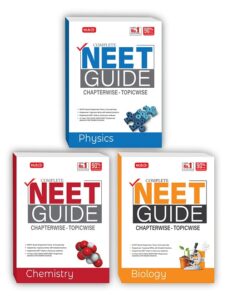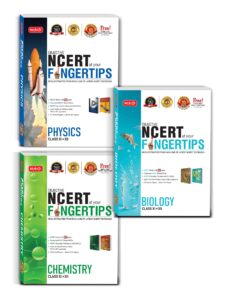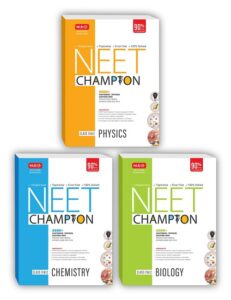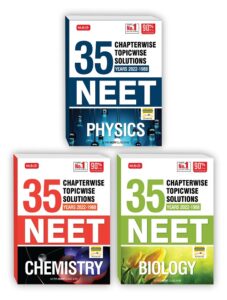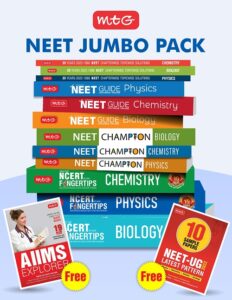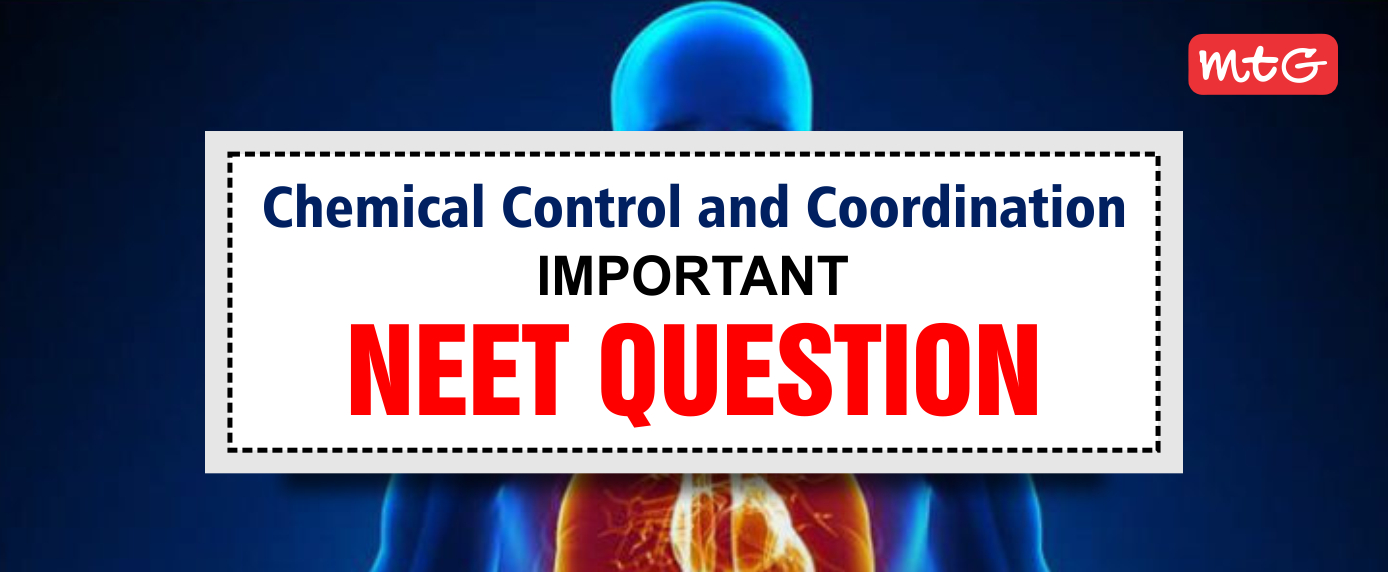
Many important questions are formed in competitive exams like NEET and boards from Class 11 Biology Chapter 22. Chemical Coordination and Integration is the 22nd chapter in the Class 11 NEET syllabus for Biology. Below, we have provided Important Questions from Class 11 Biology Chapter 22 Chemical Coordination and Integration for your NEET 2023 preparation. You can check it here for revision purposes.
Latest: Neural Control and Coordination NEET Questions and Answers
Chemical Coordination and Integration Class 11 NEET Questions and Answers
We’ve compiled a list of essential questions about Chemical Coordination and Integration biology class 11 chapter 21 that you should not miss while studying for your NEET Exams.
Chemical Coordination and Integration MCQ for NEET
Q.1. Which of the following is a steroid hormone?
(a) Insulin (b) Estrogen (c) Thyroxine (d) Glucagon
A.1. (b)
Q.2. Osteoporosis is a condition caused due to overproduction of
(a) parathyroid hormone (b) thyroid hormone (c) thyrocalcitonin (d) somatotropin
A.2. (a)
Q.3. The hypothalamus directly regulates the functioning of
(a) anterior pituitary (b) posterior pituitary (c) pars intermedia (d) pars distalis
A.3. (b)
Q.4. The diurnal rhythm of the body is regulated by
(a) serotonin (b) vasopressin (c) melatonin (d) adrenaline
A.4. (c)
Q.5. Oxytocin helps in
(a) ovulation
(b) lactation but not child birth
(c) child birth only
(d) both child birth and lactation
A.5. (d)
Q.6. The pituitary gland situated in the fossa of sella turcica of
(a) occipital bone (b) sphenoid bone (c) parietal bone (d) temporal bone
A.6. (b)
Q.7. Hypothalamic hormones reach the anterior pituitary through
(a) hypophyseal portal veins
(b) hepatic artery
(c) hepatic portal veins
(d) superior hypophyseal artery
A.7. (a)
Q.8. When blood calcium level is higher than normal, ‘X’ is stimulated and releases ‘Y’. Identify ‘X’ and ‘Y’.
(a) X – Parafollicular cells, Y – Calcitonin
(b) X – Chief cells, Y – Parathormone
(c) X – Oxyphil cells, Y – Collip’s hormone
(d) X – Follicular cells, Y – Thyroid hormones
A.8. (a)
Q.9. Immune responses of old persons become weak with aging.
This is due to the degeneration of
(a) thyroid gland (b) spleen (c) thymus (d) pineal gland
A.9. (c)
Q.10. Secretion of epinephrine and norepinephrine from adrenal medulla is under direct control of
(a) pituitary gland
(b) sympathetic nervous system
(c) parasympathetic nervous system
(d) hypothalamus
A.10. (b)
Chemical Coordination and Integration Match the Following Questions for NEET
Match column I with column II.
| Column I | Column II |
|---|---|
| A. Zona fasciculata | (i) Aldosterone |
| B. Zona reticularis | (ii) Cortisol |
| C. Zona glomerulosa | (iii) Parathyroid hormone |
| D. Chromaffin cells | (iv) Androgens |
| E. Chief cells | (v) Catecholamines |
A. A-(ii), B-(iv), C-(i), D-(v), E-(iii)
Chemical Coordination and Integration Assertion and Reason Questions for NEET
In each of the following questions, a statement of Assertion (A) is given and a corresponding statement of Reason (R) is given just below it. Of the statements, pick the correct answer as :
(a) If both A and R are true and R is the correct explanation of A
(b) If both A and R are true but R is not the correct explanation of A
(c) If A is true but R is false
(d) If A is false but R is true
Q.1. Assertion: Grave’s disease is an autoimmune disorder.
Reason: Thyroid stimulating antibodies mimic the action of TSH and stimulate the overproduction of thyroid hormones.
A.1. (a) If both A and R are true and R is the correct explanation of A
Q.2. Assertion: Calcitonin and PTH have antagonistic effects.
Reason: Calcitonin decreases blood calcium level while PTH increases blood calcium level.
A.2. (a) If both A and R are true and R is the correct explanation of A
Q.3. Assertion: Oxytocin is stored in posterior pituitary.
Reason: Oxytocin stimulates milk ejection from mammary glands in response to the stimulus provided by a suckling infant
A.3. (b) If both A and R are true but R is not the correct explanation of A
Q.4. Assertion: Tetany is associated with hypoparathyroidism.
Reason: Underactive parathyroid gland draws more calcium from the bones.
A.4. (c) If A is true but R is false
Q.5. Assertion: Diabetes insipidus is the most common abnormality associated with dysfunction of posterior pituitary.
Reason: Diabetes insipidus is caused due to excessive secretion of ADH.
A.5. (c) If A is true but R is false
Chemical Coordination and Integration Figure-Based Questions for NEET
Study the given figure and answer the following questions.
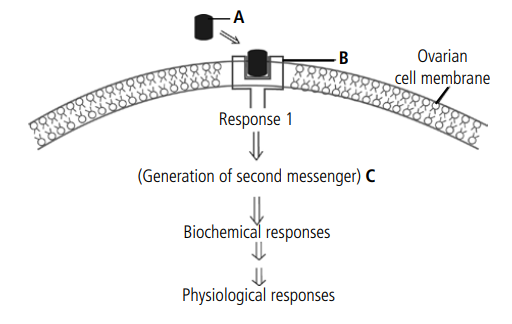
(a) Identify A, B, C, D, and E.
A. A-Hormone (e.g., FSH), B-Receptor, C-Cyclic AMP or Ca++
(b) What chemical class of hormones generate its response through the mechanism shown in the figure? Also, give three examples of hormones under this chemical class.
A. Water soluble hormones exert their response via this mechanism as they bind to receptors embedded in the plasma membrane of target cells. Example of water-soluble hormones – insulin, glucagon, parathyroid hormone, etc.
(c) How is cyclic AMP generated? Besides cAMP, name other second messengers.
A. A water soluble hormone bind with receptor at the exterior surface of a target cells’ plasma membrane. This makes the hormone-receptor complex which activates a membrane protein called G-protein. The activated G-protein in turn activates adenylyl cyclase to catalyse the conversion of ATP into cyclic AMP (cAMP). The second messenger (cAMP) regulate the metabolism of cell, causing biochemical and physiological responses in the cell. Besides cAMP, other second messenger include Ca2+, cGMP, IP3 and DAG.
Best & Most Recommended Books for NEET UG 2023 Exam
|
NEET Champion
|
35 Years NEET Chapter-wise Solutions
|
Preparing for NEET? Don’t forget to check Chapterwise Important Questions–
- The Living World NEET Questions and Answers
- Biological Classification NEET Questions and Answers
- Plant Kingdom NEET Questions and Answers
- Animal Kingdom NEET Questions and Answers
- Electrostatics NEET Questions and Answers
- Morphology of Flowering Plants NEET Questions and Answers
- Anatomy of Flowering Plants NEET Questions and Answers
- Structural Organisation in Animals NEET Questions and Answers
- Cell the Unit of Life NEET Questions and Answers
- Biomolecules NEET Questions and Answers
- Cell Cycle and Cell Division NEET Questions and Answers
- Transport in Plants NEET Questions and Answers
- Mineral Nutrition NEET Questions and Answers
- Respiration in Plants NEET Questions and Answers
- Plant Growth and Developments NEET Questions and Answers
- Photosynthesis in Higher Plants NEET Questions and Answers
- Digestion and Absorption NEET Questions and Answers
- Breathing and Exchange of Gases NEET Questions and Answers
- Body Fluids and Circulation NEET Questions and Answers
- Excretory Products and Their Elimination NEET Questions and Answers
- Locomotion and Movement NEET Questions and Answer

